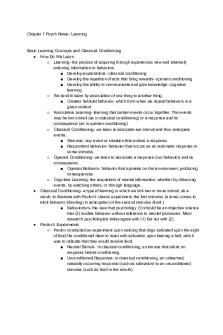Chapter 7 TB Summary PDF

| Title | Chapter 7 TB Summary |
|---|---|
| Author | Natalia Pittaway |
| Course | Introduction to Computer Applications SFW |
| Institution | University of Guelph |
| Pages | 2 |
| File Size | 64.6 KB |
| File Type | |
| Total Downloads | 7 |
| Total Views | 187 |
Summary
Download Chapter 7 TB Summary PDF
Description
Chapter 7
CIS*1000
13th Edition
NETWORKING: CONNECTING COMPUTING DEVICES Introduction to Networking
a computer network is a group of computers that connect through hardware and software to communicate benefits of networks: o sharing an internet connection o sharing printers and other peripherals o sharing files o common communications every device connected to a network is a node- can be a personal computer, a peripheral device (e.g. printer, router, switch) allow devices to share info and services with each other like files, connected devices (e.g. printers) and connection to internet Network Administrator is the person in charge of maintaining/managing the network o installing new computers and devices o monitoring the network to ensure it is performing efficiently o updating and installing new software on the network, and o configuring, or setting up, proper security for a network larger networks are difficult to manage- they usually have administrators regularly monitoring them to make sure they aren’t damaged or attacked administrators are very concerned about throughput the network o throughput: is the actual speed of data transfer that is achieved
Network Architectures classification of networks
all networks are defined by their network architecture, which is determined by 4 factors: 1. Distance between nodes 2. Network administration 3. The protocol (rules on how information is exchanged) 4. The medium (what is used to transport information) each factor can be used independently to broadly describe a computer network and all 4 combined can give a near complete definition of a particular network
network architectures defined by distance
the distance between nodes on a network is one type of network architecture or network design the distance is a common way to classify a network, common classifications include (WAN, MAN, LAN, HAN, and PAN)
WAN (Wide Area Network):
Chapter 7
CIS*1000
13th Edition
o network spans a large area. Internet is the largest of all WANs, spanning the entire globe. Other WANs may be a collection of LANs or MANs from various campuses/cities MAN (Metropolitan Area Network) o network spans a city or large geographical area- means that the entire city or area has some access to the Internet, and has been done by many cities in the USA LAN (Local Area Network) o spans a small area, usually the size of a university campus to a single room HAN (Home Area Network) o specifically, for a home. Unlike other LANs which could be a collection of computers, a HAN usually includes multiple personal computers, peripherals (e.g. printers), gaming devices, TVs and any other devices that may be at home PAN (Personal Area Network) o this network spans a very small area, typically between smartphones, tablets, or laptops using Bluetooth or local Wi-Fi
network architecture by administration
two ways of classification by administration: central vs. local central network: o network in which one computer acts as the central node o this is what a client/server network is, which is what you are connecting to whenever you play online games, connect to a website, or watch online videos o the server is providing information and facilitating communication with the clients local network: o network where every computer on the network can act as both client and server o what a peer-to-peer (P2P) network is, which is what most HANs and LANs are. o each computer on the network is capable of communicating and sharing with all of the other computers, without having to go through a central sever
Network Components the medium
all networks need 3 things to function: a medium (wire/wireless), hardware (e.g. network interface card), and software (something to translate data coming in and package data going out) wired connections: o consist of cables going directly from 1 node to another- type of cable being used depends on distance...
Similar Free PDFs

Chapter 7 TB Summary
- 2 Pages

Burger 9e TB Chapter 7
- 12 Pages

Chemistry Chapter 7 - summary
- 9 Pages

EC15 TB chapter 7 - Test Bank
- 22 Pages

Summary 1 to 7 - chapter 1-7
- 12 Pages

Chapter 7 summary- Feather Boy
- 1 Pages

CLAS 101 - Chapter 7 Summary
- 4 Pages

Attachment 7 tb assessment tool
- 1 Pages

Chapter-13 AACA TB
- 13 Pages

Ross12e Chapter 02 TB
- 19 Pages

Eun8e chapter 06 tb
- 21 Pages
Popular Institutions
- Tinajero National High School - Annex
- Politeknik Caltex Riau
- Yokohama City University
- SGT University
- University of Al-Qadisiyah
- Divine Word College of Vigan
- Techniek College Rotterdam
- Universidade de Santiago
- Universiti Teknologi MARA Cawangan Johor Kampus Pasir Gudang
- Poltekkes Kemenkes Yogyakarta
- Baguio City National High School
- Colegio san marcos
- preparatoria uno
- Centro de Bachillerato Tecnológico Industrial y de Servicios No. 107
- Dalian Maritime University
- Quang Trung Secondary School
- Colegio Tecnológico en Informática
- Corporación Regional de Educación Superior
- Grupo CEDVA
- Dar Al Uloom University
- Centro de Estudios Preuniversitarios de la Universidad Nacional de Ingeniería
- 上智大学
- Aakash International School, Nuna Majara
- San Felipe Neri Catholic School
- Kang Chiao International School - New Taipei City
- Misamis Occidental National High School
- Institución Educativa Escuela Normal Juan Ladrilleros
- Kolehiyo ng Pantukan
- Batanes State College
- Instituto Continental
- Sekolah Menengah Kejuruan Kesehatan Kaltara (Tarakan)
- Colegio de La Inmaculada Concepcion - Cebu




